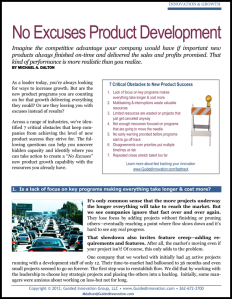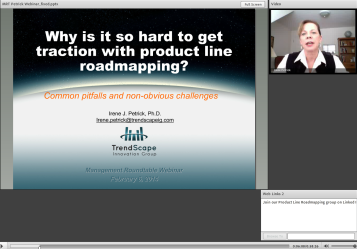
The ancient Greek engineer Archimedes is famous for saying “Give me a lever and a place to stand and I will move the world.” The beauty of the concept of leverage is that it can be applied to most of life’s efforts, whether it be moving a rock, running a shop floor, or even managing product development and innovation.
Every complex system like new product development is composed of a wide range of interdependent events, all reacting to and affecting one another simultaneously on multiple levels. When these systems reach inevitable bottlenecks or changes pop up with market conditions or customer needs, managers can easily misidentify root causes and apply the wrong resources to solve the wrong problems. Add in the dimensions of a multi-project environment and time-to-market pressure and it’s easy to feel like you’ve lost all control.
Mike Dalton, author of “Simplifying Innovation: Doubling Speed to Market With Your Existing Resources,” believes that finding the proper leverage points in your system is the key to unlocking faster cycle times by preventing you from wasting valuable time and resources. In his many years of experience leading product and business development teams, Mike has identified common leverage points each business faces which he calls “7 Critical Obstacles to New Product Success”:
- Lack of focus on key programs makes everything take longer & cost more
- Multitasking & interruptions waste valuable resources
- Limited resources are wasted on projects that just get canceled anyway
- Not enough resources focused on programs that are going to move the needle
- No early warning provided before programs start to go off track
- Disagreements over priorities put multiple timelines at risk
- Repeated crises stretch talent too far
Mike will be exploring these issues and various methods and tools for addressing them in an upcoming free webinar produced by Management Roundtable:
 Doubling Speed-to-Market and New Product Profits
Doubling Speed-to-Market and New Product Profits
How simple constraints-based methods can accelerate growth
May 15, 2014 – 1:00-2:00PM ET
For more information and to register for this session, click here. There is no fee for this webinar and you are encouraged to foward this information to any of your colleagues that you think may be interested in attending.
 As part of this webinar, we are also offering a free white paper, “No Excuses Product Development,” from Mike Dalton which further details the 7 obstacles listed above.
As part of this webinar, we are also offering a free white paper, “No Excuses Product Development,” from Mike Dalton which further details the 7 obstacles listed above.
Fill out the form below to request your free copy of this paper:
 Office furniture maker, Steelcase, Inc., has been on one heck of a journey in both Lean Manufacturing and Lean Product Development. We’ve been following their progress for a number of years and now have an opportunity to get an update on where they stand today in an upcoming webinar with Steelcase’s internal ” Office Lean Consultant,” Tim Schipper, who has worked in multiple positions at the company, including CAD, product engineering and IT, before settling into his current role in their Lean Management Office approximately 10 years ago.
Office furniture maker, Steelcase, Inc., has been on one heck of a journey in both Lean Manufacturing and Lean Product Development. We’ve been following their progress for a number of years and now have an opportunity to get an update on where they stand today in an upcoming webinar with Steelcase’s internal ” Office Lean Consultant,” Tim Schipper, who has worked in multiple positions at the company, including CAD, product engineering and IT, before settling into his current role in their Lean Management Office approximately 10 years ago. Much has happened since their early days and Steelcase has refined their lean product development into a self-feeding system they call “Rapid Learning Cycles,” which closes knowledge gaps easier and speeds up innovation. Tim Schipper will be talking about his company’s methods in an upcoming free webinar from
Much has happened since their early days and Steelcase has refined their lean product development into a self-feeding system they call “Rapid Learning Cycles,” which closes knowledge gaps easier and speeds up innovation. Tim Schipper will be talking about his company’s methods in an upcoming free webinar from 





